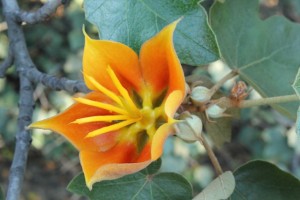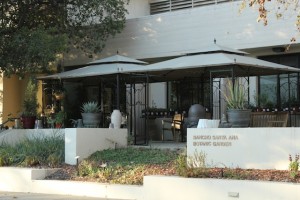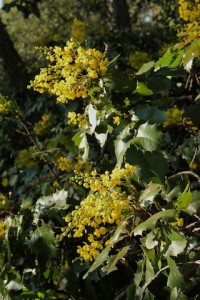How Rancho Santa Ana Botanic Garden grew, 1950-1970
Posted on | March 13, 2012 | 5 Comments
 As wild California has steadily succumbed to development during the last century, a doughty effort to conserve its native plants has been underway at the Rancho Santa Ana Botanic Garden, first at the original grounds in Santa Ana Canyon in Orange County and latterly in Claremont in Los Angeles County. This month, the Claremont garden quietly published a meticulously noted and just as meticulously translated summary of two decades of goings-on inside what amounts to a Noah’s Ark for California’s flora.
As wild California has steadily succumbed to development during the last century, a doughty effort to conserve its native plants has been underway at the Rancho Santa Ana Botanic Garden, first at the original grounds in Santa Ana Canyon in Orange County and latterly in Claremont in Los Angeles County. This month, the Claremont garden quietly published a meticulously noted and just as meticulously translated summary of two decades of goings-on inside what amounts to a Noah’s Ark for California’s flora.
As early as the 1920s, the Southland’s oak woodlands, wetlands, riparian corridors and coastal sage-scrub communities were already being destroyed at such a rate that heiress Susanna Bixby Bryant offered roughly 200 acres of her family cattle and citrus ranch in Orange County for the creation of a native plant botanic garden. The objective, recalled Rancho director Philip Munz in 1947, was collecting, growing and thus preserving “a very large percentage” of a very large state’s plants.
To establish what became the collection, Bryant employed the good and great of American botany. Among them: Munz, then a taxonomist at Pomona College; Ernest Braunton, British-born naturalist and garden editor at the Los Angeles Times from 1903-36; father of American landscape architecture Frederick Law Olmsted, Jr; Los Angeles nurseryman Theodore Payne and Berkeley botanist Willis Linn Jepson.
Starting in 1926, a botanic garden with herbarium and library were installed on Bryant’s ranch overlooking the Santa Ana River in what is now modern Yorba Linda. As the gardens were developed, a series of superintendents and resident botanists recorded every stage of every treatment of every plant, from collection in the wild, to propagation, to planting, to illness and health, to success or death. If you’ve ever wondered how seed packets can carry seemingly simple information such as germination times and interval from cotyledon to fruit, it’s years of mind-numbingly detailed work like this.
Susanna Bixby Bryant died — suddenly and unexpectedly — in 1946 shortly after the first rough summary of the garden’s work on 1,500 species, sub-species and varieties was given to her. Four years later, the foundation that she formed and largely funded moved her native garden from the 200-acre Santa Ana Canyon site to a new 80-acre location on a mesa in the San Gabriel foothills near Mt Baldy and the Claremont Colleges. Official documents explaining the move cite the happy proximity of Rancho botanists to the most learned colleges. Contemporary accounts mention problems with fire and floods. How those natural hazards made Santa Ana Canyon safer for houses than a native plant garden is unclear but Bryant’s heirs eventually sold the ranch to developers. An original ranch house is now occupied by the Yorba Linda Heritage Museum and Historical Society.

Explaining this Fremontodendron cross, O’Brien extrapolates from Everett’s notes,”Selecting one of the plants in this group, Dr. Lee W. Lenz in 1956 crossed it with F. mexicanum. Two plants were produced, and they were planted in 1957 or 1958 at the north end of the mesa. Two huge specimens have developed and were measured in 1967 at 22 and 23 feet tall with spreads of 401⁄2 and 44 feet. They have the general appearance of F. mexicanum but the great quantities of flowers produced indicate F. californicum heritage.”
The garden’s move to Claremont in 1950 brought an opportunity for both smart choices and silly ones. A silly one according to the editor of the new summary, Rancho director of special projects Bart O’Brien, was salvaging the old site’s clapped out irrigation pipes and re-installing them in Claremont, where they have caused problems ever since. A smart one was changing the original garden’s basic division of California plants from two classifications of “cover plantings” (shade trees such as pines, cypresses and oaks), and lower growing, assiduously tagged “bed plantings” to a design that organized plants by geographical communities. These communities, identified in part by by Munz while at Pomona College, would group plants from similar floristic provinces within California, including five of types of scrub (including our local coastal sage), six sorts of coniferous forest, six kinds of woodland and chaparral. Quite apart from being a healthy way to group the plants when it comes to watering regimens, for visitors, this organizational element is an important passive teaching tool about California’s many climates (and hint not to partner desert agaves with woodland coral bells.)
When the late Rancho superintendent Percy C Everett neared completion of the second summary detailing the whys and wherefores of the successes, failures and persistent mysteries encountered between 1950 and 1970, his records included notes on 112 plant families, 407 genera, 1,345 species, sub-species and varieties, and hundreds of more cultivars. As Rancho staff put in what felt like endless hours digitizing the opus, in 1993, O’Brien started work transcribing what were often clipped notes into prose. All totaled, he guesses the work took a year and a half. Every entry had classifications and nomenclature updated to reflect the terms of the 2011 second edition of the Jepson Manual.
 What is the audience for this massive effort? “There are pieces in there for everybody,” said O’Brien. “They talk about how plants did in both locations. For people who have clay soil, there’s a lot to gain from looking at that manuscript. There’s a lot about transplanting fairly mature or good-sized plants.
What is the audience for this massive effort? “There are pieces in there for everybody,” said O’Brien. “They talk about how plants did in both locations. For people who have clay soil, there’s a lot to gain from looking at that manuscript. There’s a lot about transplanting fairly mature or good-sized plants.
Some moments are thrilling. One can practically see Everett running back to the herbarium from the desert collection in March 1969 to jot down the moment that O’Brien translates as: “Plants of our accession number 7193, grown from seeds that germinated on October 26, 1950, produced four inflorescences in March 1969 … These were the first Joshua trees to ever bloom in the garden since its founding in 1927.”
O’Brien also commends Everett’s records for exacting detail on seed germination times, something that will soothe the anxious brows of many a nursery worker.
One element of the summary that leapt out at him was how growing conditions are changing, even at the same location. During his study of the first 20 years in Claremont, Everett noted a high summer temperature of 110 degrees Fahrenheit. Since then, O’Brien remembers “horrendously hot days” during which the mercury has spiked to 115. A Riverside citrus station roughly 30 miles away recorded a staggering 117 high. “Much of this area was still citrus [in Everett’s day],” he said. ” I think we are seeing some climate change and some urban heat island effect as well,” said O’Brien. “It’s one of the reasons that I wanted to get this thing published. It does tell you: Things have changed.”
Time will tell if we change too, first and foremost by looking more appreciatively at the stoic California flora that Susanna Bixby Bryant did so much to protect and explain.
Rancho Santa Ana Botanic Garden is open daily 8am-5pm. Click here to be taken to A Second Summary of the Horticulture and Propagation of California Native Plants at the Rancho Santa Ana Botanic Garden, 1950-1970 by Percy C. Everett and edited by: Bart C. O’Brien, published by Rancho Santa Ana Botanic Garden, Claremont, California March 7, 2012 Version 1.1
Tags: Bart O'Brien > chance of rain > Emily Green > Rancho Santa Ana Botanic Garden
Comments
5 Responses to “How Rancho Santa Ana Botanic Garden grew, 1950-1970”
Leave a Reply




March 13th, 2012 @ 7:41 pm
Great Piece! That top photo makes me want to visit ASAP!
March 15th, 2012 @ 4:16 pm
Wow! Great piece..can’t wait to sit down and read the summary.
Miss your seeing more of your writing…(pics are not bad either!)
March 29th, 2012 @ 12:18 pm
Well done, Emily. The document is a great read, and I for one am thankful to Percy Everett for being such a good chronicler of garden practices, and Bart O’Brien for taking the time to make this work available.
One of my favorite, though each time I have a read I find an new favorite, sections is from the part on early challenges:
We used every conceivable means [to control large rabbit population] from trapping, shooting, and poisoning, to early morning drives, when all the gardeners would line up across a designated area and slowly move them toward an open gate or corner. During the first three years, well over 3,500 rabbits by actual count were eliminated by one means or another.
Monumental task!
November 15th, 2019 @ 11:43 pm
Enjoyed this bit of history. Tried to click on multiple links to access “A Second Summary of the Horticulture and Propagation of California Native Plants at the Rancho Santa Ana Botanic Garden, 1950-1970 by Percy C. Everett and edited by: Bart C. O’Brien, published by Rancho Santa Ana Botanic Garden, Claremont, California March 7, 2012 Version 1.1” but none of them work. Possible to make those links valid and help spread the word about this valuable work?
November 16th, 2019 @ 4:43 pm
Thank you – Very sad to see that link go dead. I’ll contact RSABG on Monday to ask about a new one.